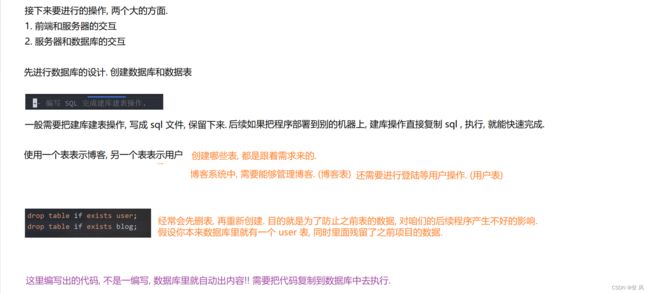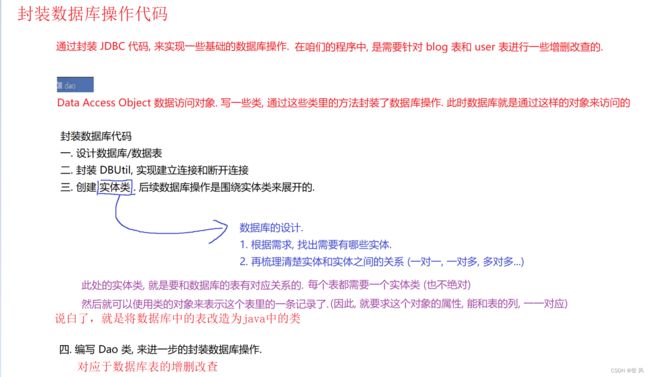JavaEE-博客系统1(数据库和后端的交互)
数据库操作代码如下:
-- 编写SQL完成建库建表操作
create database if not exists java_blog_system charset utf8;
use java_blog_system;
-- 建立两张表,一个存储博客信息,一个存储用户信息
drop table if exists user;
drop table if exists blog;
create table blog(
-- 主键必须包含唯一的值 主键列不能包含null值 设置主键进行自增长,默认从1开始,每次+1
blogId int primary key auto_increment,
title varchar(256),
content varchar(4096),
userId int,
postTime datetime
);
create table user(
userId int primary key auto_increment,
username varchar(64) unique,
password varchar(64)
);
-- 构造一些初始数据,方便后续的测试
insert into user values(1,'zhansan','123'),(2,'lisi','123');
insert into blog values(1,'这是第一篇','这里是内容',1,'2023-06-07 18:00:00');
insert into blog values(2,'这是第一篇','这里是内容',1,'2023-06-07 18:00:00');
insert into blog values(3,'这是第一篇','这里是内容',1,'2023-06-07 18:00:00');
package Dao;
import com.mysql.jdbc.jdbc2.optional.MysqlDataSource;
import javax.sql.DataSource;
import java.sql.Connection;
import java.sql.PreparedStatement;
import java.sql.ResultSet;
import java.sql.SQLException;
/**
* Created with IntelliJ IDEA.
* Description:
* User: Home-pc
* Date: 2023-10-28
* Time: 11:07
*/
//通过这个类将数据库建立连接和断开连接的逻辑进行封装
public class DBUtil {
//进行连接前的准备工作,初始化数据库地址,用户名,密码
//单例模式 只需要一个实例
//volatile 禁止指令重排序
private static volatile DataSource dataSource=null;
//提供一个方法获取datasource
private static DataSource getDataSource(){
if(dataSource==null){//此处if的作用在于避免频繁加锁;如果dataSource已经有值,再进行加锁,他会很快的解锁,但是这会导致频繁枷锁,因此一旦发现ataSource已经有值,就直接返回该值
synchronized (DBUtil.class){//为了保证线程安全(多线程问题),加锁
if(dataSource==null){//第二个if判断是否为空,当a线程优先获得锁,执行到此处,b线程没竞争到锁会被阻塞在外面,a线程判断实例是否为空,为空则new实例,a线程释放锁之后,b线程拿到锁进来后先判断instance是否为null,此时可能因上一个线程导致此处不为null,则释放锁往下或者为null
dataSource=new MysqlDataSource();
((MysqlDataSource)dataSource).setUrl("jdbc:mysql://127.0.0.1:3306/java_blog_system?useSSL=false&characterEncoding=utf8");
((MysqlDataSource)dataSource).setUser("root");
((MysqlDataSource)dataSource).setPassword("1111");
}
}
}
return dataSource;
}
//提供一个方法和数据库建立连接
public static Connection getConnection(){
try {
return getDataSource().getConnection();
} catch (SQLException e) {
e.printStackTrace();
}
return null;
}
//提供一个方法和数据库断开连接 PreparedStatement statement用来执行SQL语句 ResultSet resultSet接收执行SQL语句后返回的结果
public static void close(Connection connection, PreparedStatement statement, ResultSet resultSet){
//将3个close放置到3个try中,即使前面的close出现问题,也不会影响后续close的执行
if(resultSet!=null){
try {
resultSet.close();
} catch (SQLException e) {
e.printStackTrace();
}
}
if(statement!=null){
try {
statement.close();
} catch (SQLException e) {
e.printStackTrace();
}
}
if(connection!=null){
try {
connection.close();
} catch (SQLException e) {
e.printStackTrace();
}
}
}
}
blog.java
package Dao;
import java.sql.Timestamp;
/**
* Created with IntelliJ IDEA.
* Description:
* User: Home-pc
* Date: 2023-10-28
* Time: 12:13
*/
//这个类中的属性要和数据库中blog表中的属性相对应
//通过这个类的对象能够表示出一条blog表中的记录
public class Blog {
private int blogId;
private String title;
private String content;
private int UserId;
// SQL 里有 timestamp 类型, 还有 datetime 类型.
// 使用 SQL 时, 推荐使用 datetime, 因为 timestamp 只有 4 字节, 2038 年就不够用了.
// 但是 Java 代码中的 Timestamp 是可以使用的.
private Timestamp postTime;
public int getBlogId() {
return blogId;
}
public void setBlogId(int blogId) {
this.blogId = blogId;
}
public String getTitle() {
return title;
}
public void setTitle(String title) {
this.title = title;
}
public String getContent() {
return content;
}
public void setContent(String content) {
this.content = content;
}
public int getUserId() {
return UserId;
}
public void setUserId(int userId) {
this.UserId = userId;
}
public Timestamp getPostTime() {
return postTime;
}
public void setPostTime(Timestamp postTime) {
this.postTime = postTime;
}
@Override
public String toString() {
return "Blog{" +
"blogId=" + blogId +
", title='" + title + '\'' +
", content='" + content + '\'' +
", userId=" + UserId +
", postTime=" + postTime +
'}';
}
}
user.java
package Dao;
/**
* Created with IntelliJ IDEA.
* Description:
* User: Home-pc
* Date: 2023-10-28
* Time: 13:32
*/
//这个类的属性要和user表里的一致
//通过这个类的对象表示user表中的一条记录
public class User {
private int userId;
private String username;
private String password;
public int getUserId() {
return userId;
}
public void setUserId(int userId) {
this.userId = userId;
}
public String getUsername() {
return username;
}
public void setUsername(String username) {
this.username = username;
}
public String getPassword() {
return password;
}
public void setPassword(String password) {
this.password = password;
}
@Override
public String toString() {
return "User{" +
"userId=" + userId +
", username='" + username + '\'' +
", password='" + password + '\'' +
'}';
}
}
blogDao.java
package Dao;
import java.sql.Connection;
import java.sql.PreparedStatement;
import java.sql.ResultSet;
import java.sql.SQLException;
import java.util.ArrayList;
import java.util.List;
/**
* Created with IntelliJ IDEA.
* Description:
* User: Home-pc
* Date: 2023-10-28
* Time: 13:36
*/
//通过这个类封装对blog表的增删改查
public class BlogDao {
//1.新增一个博客,构造一个insert方法
public void insert(Blog blog){
Connection connection=null;
PreparedStatement statement=null;
try {
//和数据库建立连接
connection =DBUtil.getConnection();
//构造SQL语句
String sql="insert into blog values(null,?,?,?,now())";
//准备好sql语句
statement=connection.prepareStatement(sql);
statement.setString(1, blog.getTitle());
statement.setString(2, blog.getContent());
statement.setInt(3,blog.getUserId());
//执行SQL语句
statement.executeUpdate();
} catch (SQLException e) {
e.printStackTrace();
}finally {
//关闭连接,释放资源
DBUtil.close(connection,statement,null);
}
}
//2.查询blog表中的所有博客
public List<Blog> getblogs(){
Connection connection=null;
PreparedStatement statement=null;
ResultSet resultSet=null;
List<Blog> blogs=new ArrayList<>();//此时list为空
try {
//和数据库建立连接
connection=DBUtil.getConnection();
//构造sql语句
String sql="select * from blog order by postTime desc";//按时间顺序降序排序
//准备语句
statement=connection.prepareStatement(sql);
//执行sql
resultSet=statement.executeQuery();
//遍历结果集合
while(resultSet.next()){
Blog blog=new Blog();
//前面是java类中的属性,后面则是从数据库的表中对应属性的值
blog.setBlogId(resultSet.getInt("blogId"));
blog.setTitle(resultSet.getString("title"));
blog.setContent(resultSet.getString("content"));
blog.setUserId(resultSet.getInt("userId"));
blog.setPostTime(resultSet.getTimestamp("postTime"));
blogs.add(blog);
}
} catch (SQLException e) {
e.printStackTrace();
} finally {
DBUtil.close(connection,statement,resultSet);
}
return blogs;
}
//指定ID,查询某一个博客
public Blog getblog(int blogId){
Connection connection=null;
PreparedStatement statement=null;
ResultSet resultSet=null;
try {
connection=DBUtil.getConnection();
String sql="select * from blog where blogId=?";
statement.setInt(1,blogId);
resultSet=statement.executeQuery();
// 由于此处是按照 blogId 来查询, blogId 又是主键.
// 查询到的结果要么是 1 条记录, 要么是 0 条记录. 不会有别的情况.
// 因此这里就没必要循环了, 直接条件判定即可.
if(resultSet.next()){//查询到了,则进入;否则不会进来
Blog blog=new Blog();
blog.setBlogId(resultSet.getInt("blogId"));
blog.setTitle(resultSet.getString("title"));
blog.setContent(resultSet.getString("content"));
blog.setUserId(resultSet.getInt("userId"));
blog.setPostTime(resultSet.getTimestamp("postTime"));
return blog;
}
} catch (SQLException e) {
e.printStackTrace();
}finally {
DBUtil.close(connection,statement,resultSet);
}
return null;
}
//指定博客进行删除
public void delete(int blogId){
Connection connection=null;
PreparedStatement statement=null;
try {
connection=DBUtil.getConnection();
String sql="delete from blog where blogId=?";
statement=connection.prepareStatement(sql);
statement.setInt(1,blogId);
statement.executeQuery();
} catch (SQLException e) {
e.printStackTrace();
}finally {
DBUtil.close(connection, statement,null );
}
}
}
userDao.java
package Dao;
import java.sql.Connection;
import java.sql.PreparedStatement;
import java.sql.ResultSet;
import java.sql.SQLException;
/**
* Created with IntelliJ IDEA.
* Description:
* User: Home-pc
* Date: 2023-10-28
* Time: 14:50
*/
//使用这个类封装对user表的增删改查
public class UserDao {
//根据userId查询用户信息
public User getUserById(int userId){
Connection connection=null;
PreparedStatement statement=null;
ResultSet resultSet=null;
try {
connection=DBUtil.getConnection();
String sql="select * from user where userId = ?";
statement=connection.prepareStatement(sql);
statement.setInt(1,userId);
resultSet=statement.executeQuery();
if(resultSet.next()){
User user=new User();
user.setUserId(resultSet.getInt("userId"));
user.setUsername(resultSet.getString("username"));
user.setPassword(resultSet.getString("password"));
return user;
}
} catch (SQLException e) {
e.printStackTrace();
}finally {
DBUtil.close(connection,statement,resultSet);
}
return null;
}
//根据username来查询用户信息
public User getUserByName(String username){
Connection connection=null;
PreparedStatement statement=null;
ResultSet resultSet=null;
try {
connection=DBUtil.getConnection();
String sql="select * from user where username = ?";
statement=connection.prepareStatement(sql);
statement.setString(1,username);
resultSet=statement.executeQuery();
if(resultSet.next()){
User user=new User();
user.setUserId(resultSet.getInt("userId"));
user.setUsername(resultSet.getString("username"));
user.setPassword(resultSet.getString("password"));
return user;
}
} catch (SQLException e) {
e.printStackTrace();
}finally {
DBUtil.close(connection,statement,resultSet);
}
return null;
}
}





